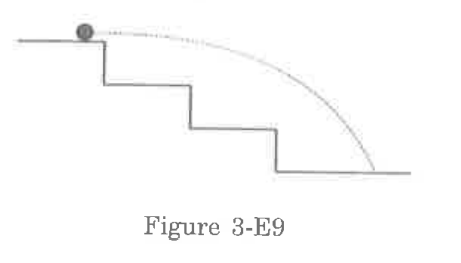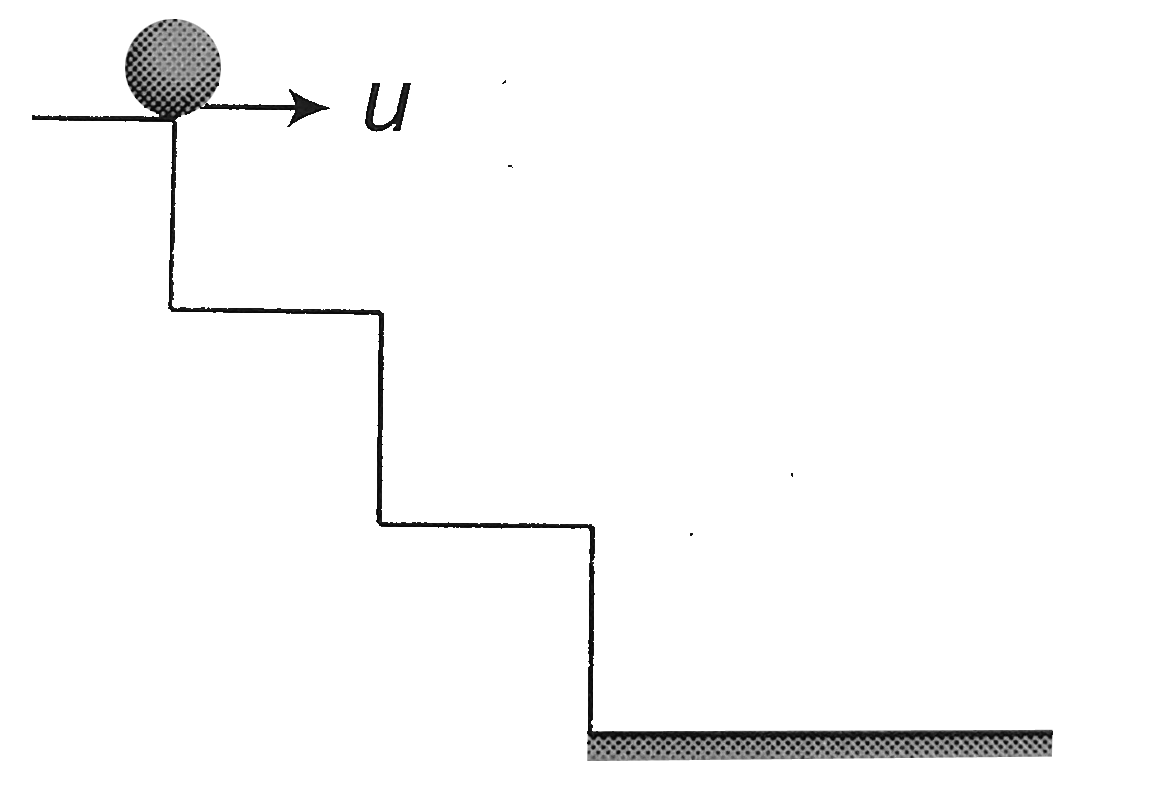A ball rolls off the top of a stariway with a horizontal velocity magnitude 150 cm/sec. The steps are 20 cm high and 20 cm wide . Which step will the ball hit first ?
To solve the problem of determining which step the ball will hit first, we can break it down into a series of steps:
Step 1: Understand the problem
The ball rolls off a stairway with a horizontal velocity of 150 cm/s. The height and width of each step are both 20 cm. We need to find out which step the ball will hit first.
Step 2: Set up the equations
Let:
- n = number of the step the ball hits
- y = vertical distance fallen by the ball = n×0.2 m (since each step is 20 cm high)
- x = horizontal distance traveled by the ball = n×0.2 m (since each step is 20 cm wide)
- u = horizontal velocity = 150 cm/s = 1.5 m/s (converting to meters)
- g = acceleration due to gravity = 9.8 m/s²
Step 3: Vertical motion equation
The vertical distance fallen can be described by the equation of motion:
y=12gt2
Substituting for y:
n×0.2=12gt2
Step 4: Horizontal motion equation
The horizontal distance traveled can be described as:
x=ut
Substituting for x:
n×0.2=ut
From this, we can express t:
t=n×0.2u
Step 5: Substitute t into the vertical motion equation
Substituting t from the horizontal motion into the vertical motion equation:
n×0.2=12g(n×0.2u)2
This simplifies to:
n×0.2=12g(n×0.2)2u2
Step 6: Rearranging the equation
Rearranging gives:
n=2u2×0.2g×0.22
This simplifies to:
n=2u2g×0.2
Step 7: Substitute values
Now substituting the known values:
- u=1.5 m/s
- g=9.8 m/s²
n=2×(1.5)29.8×0.2
Calculating:
n=2×2.251.96=4.51.96≈2.29
Step 8: Determine the step number
Since n≈2.29, we round it to the nearest whole number, which is 3. Therefore, the ball will hit the third step first.
Final Answer
The ball will hit the third step first.
---
The ball rolls off a stairway with a horizontal velocity of 150 cm/s. The height and width of each step are both 20 cm. We need to find out which step the ball will hit first.
Let:
- n = number of the step the ball hits
- y = vertical distance fallen by the ball = n×0.2 m (since each step is 20 cm high)
- x = horizontal distance traveled by the ball = n×0.2 m (since each step is 20 cm wide)
- u = horizontal velocity = 150 cm/s = 1.5 m/s (converting to meters)
- g = acceleration due to gravity = 9.8 m/s²
The vertical distance fallen can be described by the equation of motion:
y=12gt2
Substituting for y:
n×0.2=12gt2
The horizontal distance traveled can be described as:
x=ut
Substituting for x:
n×0.2=ut
From this, we can express t:
t=n×0.2u
Substituting t from the horizontal motion into the vertical motion equation:
n×0.2=12g(n×0.2u)2
This simplifies to:
n×0.2=12g(n×0.2)2u2
Rearranging gives:
n=2u2×0.2g×0.22
This simplifies to:
n=2u2g×0.2
Now substituting the known values:
- u=1.5 m/s
- g=9.8 m/s²
n=2×2.251.96=4.51.96≈2.29
Since n≈2.29, we round it to the nearest whole number, which is 3. Therefore, the ball will hit the third step first.
The ball will hit the third step first.
Topper's Solved these Questions
- MOTION IN A PLANEBOOK - AAKASH SERIESCHAPTER - MOTION IN A PLANEEXERCISE - SHORT ANSWER TYPE QUESTIONS
6 Videos
- MOTION IN A PLANEBOOK - AAKASH SERIESCHAPTER - MOTION IN A PLANEEXERCISE - VERY SHORT ANSWER TYPE QUESTIONS
10 Videos
- MOTION IN A PLANEBOOK - AAKASH SERIESCHAPTER - MOTION IN A PLANEEXERCISE - EXERCISE-3 (Circular Motion)
7 Videos
- MOTION IN A STRAIGHT LINE BOOK - AAKASH SERIESCHAPTER - MOTION IN A STRAIGHT LINE EXERCISE - very Short answer type question
15 Videos
Similar Questions
Show that the trajectory of an object thrown at certain angle with the horizontal is a parabola .
View SolutionWhat is the limitation of the first law of thermodynamics?
View SolutionA particle 'P' is moving in a circle of radius 'a' with a uniform speed 'u' 'C' is the centre of the circle and AB is a diameter. The angular velocity of P about A and C are in the ratio
View SolutionGive two examples of the motion of big objects where the object can be treated as a particle and where it cannot be?
View SolutionA staircase contains three steps each 10 cm high and 20 cm wide figure. What should be the minimum horizontal velocity of a bal rolling off the upper most plane so as to hit directly the lowest plane?

View SolutionA ball rolls off top of a staircase with a horizontal velocity u m s^-1 . If the steps are h metre high and b mere wide, the ball will just hit the edge of n th step. Find the value of n .
View SolutionA ball rolls off top of a staircase with a horizontal velocity ums−1. If the steps are h metre high and b mere wide, the ball will just hit the edge of nth step. Find the value of n.
View SolutionA staircase contains four steps each 20cm high and 40cm wide. What should be the minimum horizontal velocity of a ball rolling off the uppermost plane so as to hit directly the lowest plane ?
View SolutionA staircase contains four steps each 10cm high and 20cm wide. The minimum horizontal velocity of a ball rolling off the uppermost plane so as to hit directly the lowest plane is

View SolutionA ball rolls off top of a stair case with horizontal velocity ums if the steps are h meter high and b meter wide, the ball will just hit the edge of nth step. Then value of n is:
View SolutionA ball rolls off the top of a stariway with a horizontal velocity magnitude 150 cm/sec. The steps are 20 cm high and 20 cm wide . Which step will the ball hit first ?
View SolutionA ball rolls of the top of a stariway with a constant horizontal velocity u. If the steps are h meter high and w meter wide , show that the ball will just hit the edge of nth step if n=2hu2gw2 .
View SolutionA sphere rolls off the top of a stairway with a horizontal velocity of magnitude 200 cm/sec. The steps are 10 cm high and 10 cm wide. Which step will the ball hit first?(g=10 m/s2)
View SolutionA ball rolls off the top of a stairway with a constant horizontal velocity u. If the steps are h metre high and w metre wide, show that the ball will just hit the edge of nth step if n=2hu2gw2
View SolutionThe height and width of each step of a staircase are 20 cm and 30 cm respectively. A ball rolls off the top of a stair with horizontal velocity v and hits the fifth step. The magnitude of v is (g = 10 ms^(-2))
View SolutionA sphere rolls off the top of a stairway with a horizontal velocity of magnitude 200 cm/sec. The steps are 10 cm high and 10 cm wide. Which step will the ball hit first ? (g=10m/s2)
View Solution

